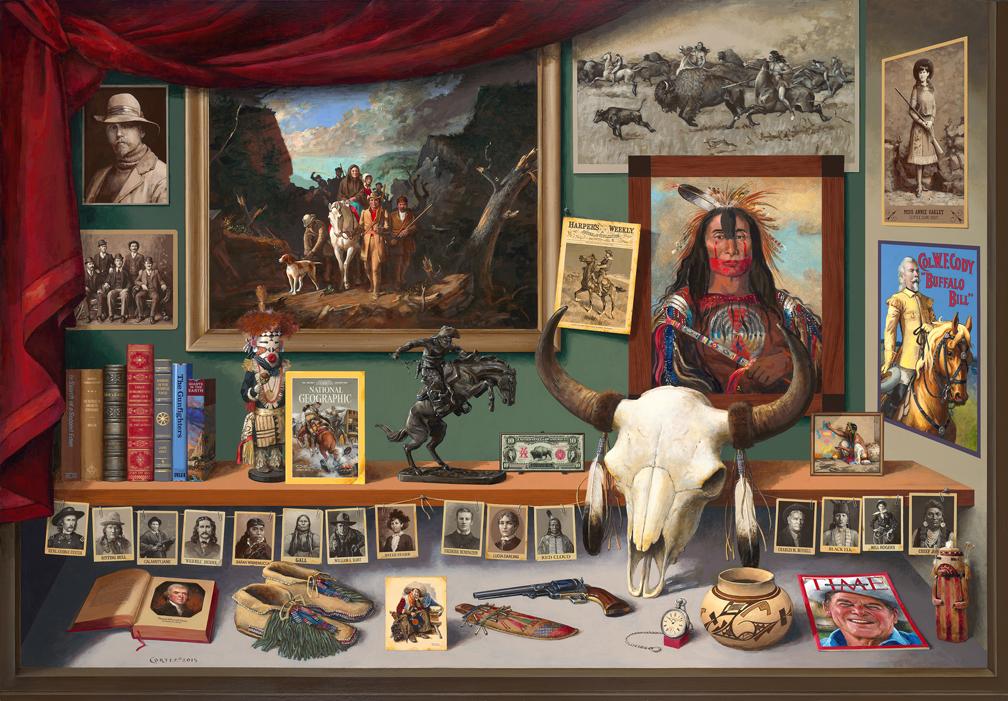© by Jenness Cortez –
Acrylic on mahogany panel, 42 by 60 inches
In 1801, when Thomas Jefferson became president, two out of every three Americans lived
within fifty miles of the Atlantic Ocean. To our west, France owned the vast, largely
unexplored Louisiana Territory where Napoleon hoped to establish an empire in the New
World. In 1802, Jefferson offered to buy the port of New Orleans from France but Napoleon
Bonaparte, strapped for cash to fund his wars, counter-offered to sell the entire Louisiana
Territory, 820,000 square miles, for $15 million––an amount which was twice the federal
budget. Jefferson more than doubled the size of the country with a stroke of his pen.
The purchase was called “Jefferson’s Folly” by many. Today we know Jefferson’s vision as
the birth of the American West. This painting documents exactly 200 years of the West’s
history; from 1804 when Jefferson dispatched Lewis and Clark’s expedition, to 2004 and
the passing of our first truly western president, Ronald Reagan.
On back wall:
Edward S. Curtis self portrait photogravure 1899
“Fort Worth Five”
front row left to right: Harry A. Longabaugh (Sundance Kid), Ben Kilpatrick (the Tall Texan), Robert Leroy Parker (Butch Cassidy)
standing: Will Carver and Harvey Logan (Kid Curry)
1900 photograph by John Schwartz, Smithsonian Institution’s National Portrait Gallery
George Caleb Bingham (1861-1879)
“Daniel Boone Escorting Settlers through the Cumberland Gap” Mildred Lane Kemper Art Museum
Frederic Remington (1811-1909)
“In from the Night Herd” engraving after Remington drawing, “Harper’s Weekly” October 9, 1886
“Her Calf” en grisaille, Amon Carter Museum of American Art
George Catlin (1796-1872)
Blackfoot Chief “Stu-mick-o-súcks (Buffalo Bull’s Back Fat) Head Chief, Blood Tribe”
Smithsonian American Art Museum
Annie Oakley (Phoebe Ann Mosey) studio portrait
Col. W.F. Cody, 1908 Buffalo Bill lithograph
On the shelf:
Albert Bierstadt (1830-1902)
“Emigrants Crossing the Plains” The Butler Institute of American Art
Kachina (Paiyatemu), Zuni late 19th century Brooklyn Museum
Frederic Remington (1861-1909)
“The Broncho Buster” Bronze, Metropolitan Museum
1901 $10 Legal Tender Bison Note; Early 20th century buffalo skull
Eanger Irving Couse (1866-1936)
“The Kachina Painter” private collection
Charles M. Russell (1864-1926)
“Bronc to Breakfast” watercolor, “National Geographic” January 1986, Montana Historical Society
Carte de visite photographs:
Gen. George Armstrong Custer, National Photographic Art Gallery
Sitting Bull, Hunkpapa Lakota holy man and tribal chief
Calamity Jane (Martha Jane Canary) frontierswoman and scout
James Butler “Wild Bill” Hickok, lawman, gunfighter
Sara Winnemucca, social reformer for Native American rights c.1880
Chief Gall (Pizi) Hunkpapa Sioux 1881 photographed by David F. Barry, National Archives
William S. Hart, silent film actor
Myra Maybelle Shirley Reed (Belle) Starr, outlaw, Oklahoma Historical Society
Frederic Remington at Yale, Dow Studios, Amon Carter Museum of American Art
Lucia Darling, first Montana school teacher 1863, Beaverhead County Museum
Red Cloud, photographed by Charles Milton Bell 1880
Charles M. Russell, Harry Pollard photographer 1919, Brian W. Dippie Collection
Black Elk, Oglala Lakota (Sioux) medicine man
William Penn Adair “Will” Rogers humorist, 19th century photograph
Chief Joseph–Nez Perce photogravure by Edward Curtis early 20th century
Foreground display:
Rembrandt Peale (1778-1860)
“Thomas Jefferson,” White House Historical Association; Kiowa Moccasins c. 1870, private collection
Norman Rockwell (1894-1978)
“Dreams of Long Ago” Saturday Evening Post August 13, 1927
Apache knife and sheath 1870
Colt 1851 Navy Revolver
1890 pocket watch, American Waltham Watch Company
Acoma Olla (jar) c. 1770 private collection
“Time” (magazine) Ronald Reagan Commemorative Issue, June 14, 2004
Kachina, Kana-A Hopi c.1880
